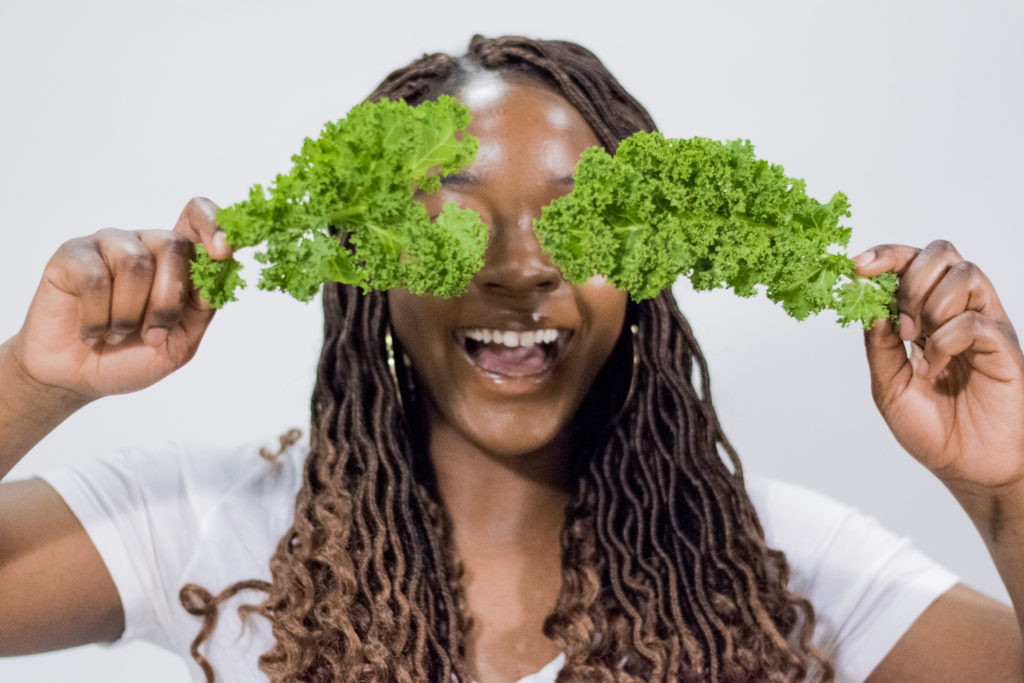Food for Your Eyes
Featured in Penn Appetit's Spring 2018 Issue

Originally published in our spring 2018 issue: See Food
By Nina Selipsky
Photos by Minna Zheng and Justine de Jesus

When I was a kid, my mom always tried to convince me to eat my carrots, saying they were “food for my eyes.” I usually ate them raw and plain at home, actually enjoying each bite’s crisp, satisfying crunch. When I went to my grandmother’s house, she would boil baby carrots in water and honey to make them sweet for me. The honey permeated through the bitter skin of the carrots, transforming them into candy and making me forget that I was actually eating vegetables.
Years later, I am still an avid fan of carrots. And with no vision problems so far, I like to think that my family’s insistence on the orange vegetable played a role. Thinking back on those first experiences, I began to wonder: why are carrots good for the eyes? I had been hearing my whole life that they were a vision-benefitting food, but I realized I did not completely know why. What properties make certain foods good for eyesight? I set out to find the answer, as well as inspiration for a few new vision-food recipes. After some careful research, I discovered that there are far more options than just carrots if you’re looking to fuel your eyes.

Think about the foods that tend to catch your eye at the grocery store, such as bright yellow and orange fruits and vegetables. These are the foods packed with vitamins for your eyes to devour. Other choices include egg yolks and leafy greens. Besides being ingredients in so many recipes, these foods also take on the role of ingredients in art.
Tempera, the most ancient method of painting, was made by mixing egg yolk, pigment, and water. The mixture was applied by artists in the Middle Ages to wood, clay, plaster, stone, parchment, and canvas. While making my own tempera paint in my art history class, I had the sense that I was carrying out a recipe as I separated out the egg whites from the yolk. I find a slight poetry in the fact that these foods, which are nutritious for the eyes, also draw the eye with their color palette and their capacity to become something so visually pleasing as the tapestries in the National Gallery or Hampton Court in London.
The vitamins, minerals, and antioxidants found in these foods may play a role in preventing two common vision problems: cataracts–cloudy areas in the lens of the eye–and age-related macular degeneration (AMD). AMD is a condition that causes vision loss in the macula, the part of the eye that is responsible for central vision.
Just as pigment can be applied to a canvas to create art and please the eye, it can also protect the eyes from within. Dietary intake of the compounds lutein and zeaxanthin, which are found in the retina, has been shown to have antioxidant properties and to improve pigment density in the macula. This pigment protects the cells in the macular area by absorbing excess blue and ultraviolet light and neutralizing free radicals.
Free radicals in the retina damage proteins and DNA within cells. Antioxidants, zinc, and minerals A, C, and E fight free radicals and help to protect the eyes, too.
Next time you’re at the grocery store, think of the foods as colors you’re adding to your paint palette. Those bright yellows, oranges, and greens will ensure your vision stays vibrant for a long time. And if you ever want to make tempera paint, you’ll have the supplies.
Notes
Yellow and orange fruits and vegetables
Egg yolks
Fatty cold-water fish
“Certain vitamins and minerals found in food may play a role in preventing two common causes of vision problems: cataracts—cloudy areas in the lens of the eye—and age- related macular degeneration (AMD)—a condition that causes vision loss in the macula, the part of the eye that controls central vision.”
“Dietary antioxidant vitamins and minerals (A, C, and E, and the mineral zinc) may help prevent the progression of macular degeneration.”
The retina has many free radicals, which damage proteins and DNA within cells. Antioxidants fight free radicals and help to protect the retina.
“Lutein and zeaxanthin are carotenoids found in the retina, and dietary intake of these compounds has been shown to have antioxidant properties and to improve pigment density in the macula. This pigment protects the cells in the macular area by absorbing excess blue and ultraviolet light and neutralizing free radicals.”
“Omega-3 fatty acids have been shown to have anti-inflammatory properties, and there is evidence to suggest that inflammation plays a role in AMD.” (Dr. Ivana Kim)
Fish at least twice a week and at least five servings of fruits and vegetables daily
From National Eye Institute:
“You’ve heard carrots are good for your eyes. But eating a diet rich in fruits and vegetables, particularly dark leafy greens such as spinach, kale, or collard greens is important for keeping your eyes healthy, too. Research has also shown there are eye health benefits from eating fish high in omega-3 fatty acids, such as salmon, tuna, and halibut.”